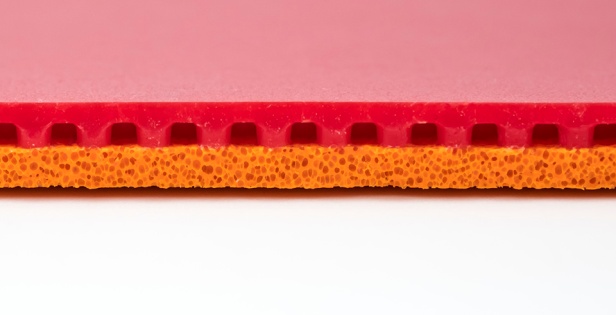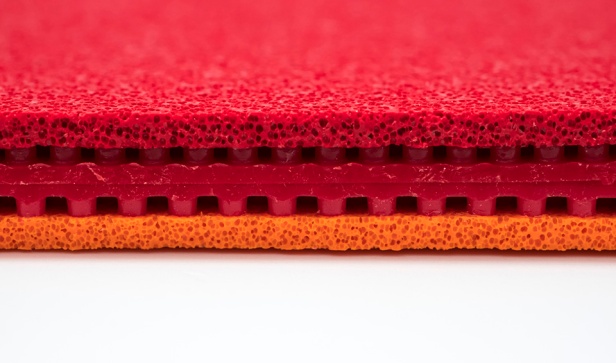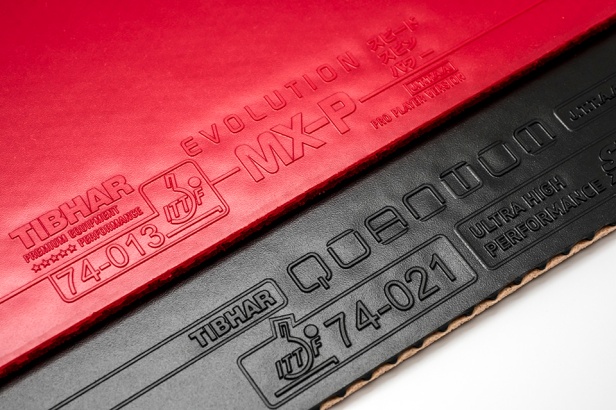1. Introduction

At present, there are five families of ‘new generation’ tension rubbers in rubber range of Tibhar. Those four are Evolution series, Q series, Quantum series, Aurus series and Genius series. Among those five, Evolution series is the representative rubber family of Tibhar, which is prepared for most of needs from players by suggesting six variations. Q series is also top family. 5Q VIP, which is the top model of Q series, is also one of the top model of current rubber range of Tibhar.Aurus series is low cost model which is concentrated on speed instead of spin. Genius series is the first family of ‘new generation’ tension rubbers which is announced during 2009~2010. Genius series was once the top rubber family of Tibhar. But, now it is dealt as entry model of new generation tension rubber, at the same time with newer Aurus family. And, Quantum series is the most recent rubber family.
(Newer models – Aurus Prime and Aurus Select will be launched sooner or later. Those two are included in Aurus series. But, in fact, those two are completely new ones with improved technology. I will get samples as soon as possible and will introduce the features of Aurus Prime/Select.)

Tibhar is introducing Evolution series as ‘Pro Player Version’ which is suggested to top players. The newest rubber technology is being applied to Evolution series. Although its character is different from that of Evolution series, 5Q VIP is also made by the newest technology, and is also suggested to top players. (Differently from 5Q VIP, 1Q and 5Q is made by one step older technology of new generation tension rubber.) However, Quantum series is not being introduced as the rubber for top players although it is the newest rubber family. It seems that Quantum series is positioned between Q series and Aurus/Genius family. For that reason we may think that Quantum series is just the new version of Aurus series or Genius series, and is also aiming at amateur players including entry players. However, Quantum series is more than entry rubber, although its light weight and ease of use makes entry players use it without trouble.

Quantum series is the weapon of Tibhar for the competition against Butterfly Tenergy 64. So far the pimple geometries of the most of new generation tension rubbers from Tibhar have been Type A or Type A’. (Please refer to posting : Three typical pimple geometries of ‘New Generation’ tension rubbers.) Type B geometry – low density arrangement – has been applied for only two models – Genius+ Optimum and Genius+ Optimum Sound. Even the pimple geometry of Aurus whose top sheet is very soft is Type A’. For that reason, so far there haven’t been many models which can be directly compared to Tenergy 64. The meaning of Quantum series is the newest model which can directly compete with Butterfly Tenergy 64. Now Tibhar has high-low combination of rubbers with Type B geometry. ‘High’ models with newer technology are Quantum and Quantum S. ‘Low’ models which is can be considered as entry version of Type B geometry are Genius+ Optimum and Genius+ Optimum Sound.

2. Features

There are two variations in Quantum series – Quantum and Quantum S. As is shown in above picture, two models share top sheet of the registration number 74-021. For that reason, on the top sheet of Quantum S it is not written as ‘Quantum S’ but just as ‘Quantum’. Two variations are distinguished by sponge color.
The sponge color for Quantum is cream, and that for Quantum S is orange. ‘Quantum’ is regular version whose sponge density is 50 degree. And, ‘Quantum S’ is soft version whose sponge density is 45 degree. You may have question that 45 degree is not proper to be called as ‘soft’ version. However, please note that ‘hard’ or ‘soft’ is always relative expression. The same density can be ‘hard’ version for one rubber and ‘soft’ version for other rubber at the same time. The good example is the sponge for Butterfly Tackifire Special Soft and Flextra Hard. That sponge was called as ‘soft’ because it was softer than the sponge of regular version of Tackifire Speial, and was called as ‘hard’ because it was harder than the sponge of regular version of Flextra.
In fact, Quantum S is much softer than expected from the value of density. You may feel as if the sponge density of Quantum S were about 40 degree. Similarly, Quantum whose sponge density is 50 degree is not as hard as we expect from value. Its sponge density is felt as if it were about 45 degree.
The softness of Quantum series is due to its pimple geometry.
The pimple geometry of Quantum is categorized as ‘Type B’. It means that the density of pimple is low. The distance between pimple and pimple is about 2.7mm. It is similar to that of Tenergy 64. (In fact, the distance between pimple and pimple of Tenergy 64 is a bit smaller than 2.7mm although Butterfly officially announced that it is 2.7mm.)
Regarding the types of pimple geometry, please refer to posting : Three typical pimple geometries of ‘New Generation’ tension rubbers.
Above picture shows the comparison between the pimple geometry of Quantum series and that of Evolution series. The one with red sponge is Evolution MX-P, and the one with orange sponge is Quantum S. The pimple geometry of Evolution MX-P is ‘Type A’. The gap between the pimples of Quantum series is noticeably bigger than that of Evolution series. That is the reason why the top sheet of Quantum series is much softer than that of Evolution series.
The pore of sponge of Quantum series is as big as that of Evolution series. It is assumed that the same level of sponge technology is being applied to both of Quantum series and Evolution MX-P.
The look and feel of the top sheet of Quantum series is not different from that of Evolution series. Even the microstructure of surface is identical.
Although Quantum is not being introduced as a rubber for top players, Quantum doesn’t look cheaper than Evolution series. It looks like that the same level of technology is being applied to Quantum and Evolution series. The only noticeable difference exists only at pimple geometry. So we can assume that the relationship between Evolution series and Quantum series is similar to that between Butterfly Tenergy 05 and Tenergy 64, or that between Genius and Genius+ Optimum. (The pimple geometry of Genius+ Optimum is Type B, while the pimple geometry of Genius is Type A’.)
3. Field Test

I also tested Quantum (50 degree version) and Quantum S (45 degree version) at club, with some typical blades. The most frequently used blade is Tibhar Samsonov Force Pro Black Edition (I will call it as SBE). I also used slower 5-ply wood blades and harder/faster blades. Only poly ball is used for testing.
When combined with SBE, Quantum easily makes very speedy ball. The ball draws very long and linear trajectory. Although the trajectory is linear, the rotation of ball is more than expected. So the ball draws dramatic curve at the end of trajectory. In my personal opinion, the combination of Quantum and thick 7-ply blade such as SBE will not be comfortable if player plays at close-to-table area. However, if player likes attack from mid-range, player will feel that it provides optimum trajectory. Quantum fits for active offensive play with topspin from mid distance, when it is combined with typical thick 7-ply wood blade.
On the contrary, Quantum S is biased to control. When it is combined with SBE, speed of ball is moderate, while spin is more than expected. The harmony of moderate rebound and good spin results in excellent stability and high precision of ball placement. Although I’m telling that the speed from the combination of Quantum S and SBE is just ‘moderate’, it doesn’t mean that it is not a powerful combination. Because it is very balanced combination, everything depends on what player does. All kinds of table tennis technics will be easily performed with this combination, except for destructive smash. Also Quantum S is not sensitive to small mistake of player. It behaves as if it absorbs and neutralizes small mistake concerning impact angle or timing. If the player lays emphasis especially on the variation of topspin, this combination may be very satisfactory.
If the blade becomes slower and softer, Quantum S becomes even more controllable and comfortable. For example, the combination of Quantum S and thin 5-ply blade with OFF- or ALL+ class provides almighty control. However the price is of course additional reduction of speed. This kind of combination will fit for entry level players or the players who lays more emphasis on control than power. If the players want more balanced performance, thick 7-ply blades will be better selection than thin 5-ply blades.
Differently from Quantum S, Quantum makes very balanced combination with slower 5-ply wood blades. Reduced rebound of blade makes the trajectory of ball from Quantum shorter when compared with the case that Quantum is combined with SBE. The speed of ball is reduced. However, the ball becomes heavier. And, the adjustment of the amount of spin and the flying distance is very easy. For that reason, if player sticks to slow/soft blade, I recommend Quantum instead of Quantum S. But, if player wants best control, Quantum S is of course considerable. Especially for backhand side.
If the blade is harder than SBE, Quantum may be too hard. The ease of use will be reduced, and sometimes it results in the decrease of power. In that case, player can optimize the characteristics of combination by replacing Quantum with softer Quantum S.
What is impressive is the spin performance of Quantum and Quantum S. Both of those two provide better spin than expected from the pimple geometry. Although Quantum series doesn’t provide the same level of spin performance as Evolution MX-P, the soft top sheet of Quantum series let player easily enjoy sufficient spin in offensive strokes done with moderate speed of swing. The players of middle ~ low class may feel that Quantum series is much more comfortable than Evolution series.
Older Genius+ Optimum has the same pimple geometry as Quantum series. When compared to Genius+ Optimum, the top sheet of Quantum series is harder although it is still much softer than the rubbers with dense pimple arrangement. I had always thought that Genius+ Optimum is much softer than its competitor : Butterfly Tenergy 64. But, by hardening the top sheet, the feeling of Quantum series has become close to that of Tenergy 64.
When compared to Butterfly Tenergy 64, Quantum is somewhat harder than Tenergy 64. The feeling of Quantum S is closer to that of Tenergy 64. However, Quantum S is a bit slower than Tenergy 64. On the contrary Quantum is faster than Tenergy 64. If a player is searching for a rubber which is similar to Tenergy 64 but provides better control, Quantum S will be the solution. But, if a player feels that Tenergy 64 is softer than optimum, Quantum can be good solution for the adjustment.
4. Summary

Quantum and Quantum S are ‘New Generation’ tension rubbers, and can be categorized as ‘Type B’ (= Tenergy 64 type). Quantum and Quantum S share the pimple geometry with Genius+ Optimum. The pimples of top sheet are arranged sparsely, and for that reason the feeling of top sheet is very soft. The sponges of Quantum and Quantum S look very similar to that of Evolution MX-P or Evolution EL-P except for the colors of sponges. The top sheet of Quantum and Quantum S are harder than that of Genius+ Optimum. It makes the feeling of sponge relatively softer than expected. However, the top sheet of Quantum series is much softer than that of rubbers with high density geometry (= Type A or Type A’) such as Evolution series or Q series.
Because the pimple geometry of Quantum series is not aiming at best spin performance but the balance between spin and speed, the maximum spin performance of Quantum series is not as good as that of Evolution series whose pimple geometry is fundamentally optimized for spin. It isn’t expected that the spin performance of Quantum series will satisfy top players. However, in many situations of the game of normal level, actual spin performance of Quantum series is much better than expected. Sufficient spin, very soft feeling and a bit less speed than expected make Quantum series very comfortable and safe. A bit reduced speed is compensated by a bit harder (= 50 degree) sponge of Quantum. (‘A bit harder’ means that the sponge of Quantum is a bit harder than 47.5 degree sponge which is applied for most or regular version of ‘New Generation’ tension rubbers.) On the contrary Quantum S which is equipped with a bit softer (= 45 degree) sponge is for the players who lay emphasis on balance and control. Both of Quantum and Quantum S are recommended as the replacement of Tenergy 64 or the rubbers of same type (Type B geometry).

QUANTUM (50 degree version)
PROS
• High speed and good control.
• Soft top sheet is very comfortable, and provides good adaptability.
• Spin is better than expected from its pimple geometry.
• Long trajectory is good for the topspin from mid distance.
CONS
• Linear trajectory may be uncomfortable for the attack at close-to-table area.
• Feeling may be somewhat hard due to the sponge which.
RECOMMENDED
• High class players who lay emphasis on the balance between speed and spin.
• The players who are searching for top class rubber that can make good balance with soft blades.
NOT RECOMMENDED
• The players who don’t like hard feeling of sponge.
• Close-to-table players who prefer topspin to smash.

QUANTUM S (45 degree version)
PROS
• Maximum comfort and safety.
• Spin is better than expected from its pimple geometry.
• Excellent balance when it is combined with hard/fast blades.
CONS
• Feeling may be too soft because it is much softer than expected from the value of density.
• Speed is worse than expected, especially when combined with mid or low speed blades.
RECOMMENDED
• All-round players who lay emphasis on control and safety.
• Very aggressive players who play with close-to-table topspin.
• Entry players who want to use top class rubber.
NOT RECOMMENDED
• The players who play with power-oriented strategy.
• The players who require maximum spin capability.

Unauthorized use and/or duplication of this material without express and written permission from this blog’s author and/or owner is strictly prohibited. Excerpts and links may be used, provided that full and clear credit is given to TTGear Lab with appropriate and specific direction to the original content.





Amazing analysis, Congratulation!
LikeLike
Thank you for comment!
LikeLike
Thanks for sharing. Based on your information, I will stick with Stiga Mantra S and M.
LikeLike
Thank you for comment. If you like Stiga Mantra S, changing to Quantum S is not a good way because those two rubbers are so different. If you are interested in Tibhar rubber, I recommend ‘Evolution FX-S’ as the replacement of ‘Quantum S’. ‘Evolution **-S’ can be directly compared with ‘Mantra’ series. Both of those are for spin.
LikeLike
Dear tester,
Please share us your impression about the incoming spin sensitivity of the Quantum S rubber. Thanks in advance: József
LikeLike
I think that Quantum S is not sensitive to incoming spin. But, at the same time we can’t easily make heavy rotation from Quantum S.
LikeLike
Thanks. I already bought one and I am relatively satisfied.. all the good things of the Gewo rubbers and the Tibhar sponge.
LikeLike